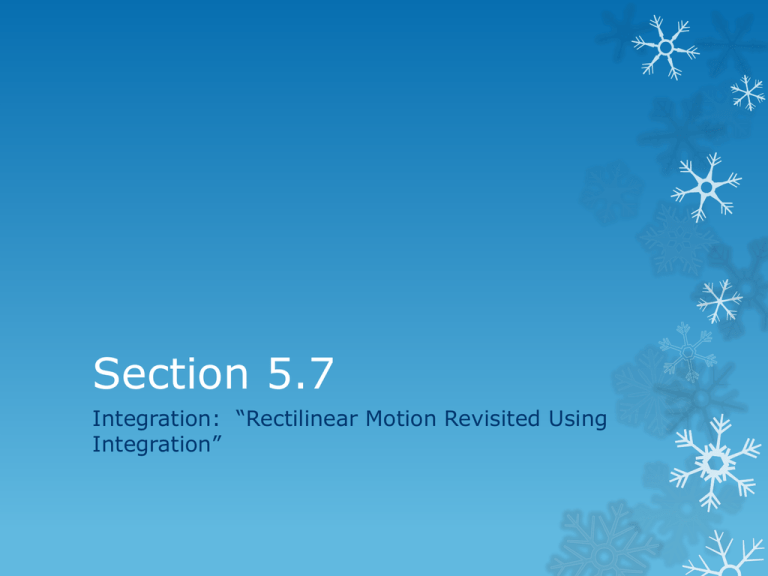
Section 5.7
Integration: “Rectilinear Motion Revisited Using
Integration”
All graphics are attributed to:
Calculus,10/E by Howard Anton, Irl Bivens, and Stephen
Davis
Copyright © 2009 by John Wiley & Sons, Inc. All rights
reserved.
Introduction
In Section 4.6 we used the derivative to find
velocity and acceleration for a particle in
rectilinear motion.
v(t) = s’(t)
and
a(t) = v’(t) = s”(t)
In this section, we will use the integral to
reverse the process.
Example
Computing Displacement by
Integration
Since displacement is final position minus
initial position, it can be written as follows in
integral form:
This is a special case of a form of the
Fundamental Theorem of Calculus from
section 5.6:
Computing Distance Traveled by
Integration
Distance traveled is different than displacement
because it is the total of all of the distances
traveled in both positive and negative directions.
Therefore, we must integrate the absolute value of
the velocity function:
NOTE: Integrating velocity over a time interval
produces displacement, and integrating speed over
a time produces distance traveled.
Example
Use a and b as
given in question.
First determine
where the
particle turns
around, then
use Theorem
5.5.5 to break
into parts.
Analyzing the Velocity vs. Time
Curve
As you hopefully saw in the last example, the
integral is the “net signed area” under the
velocity curve v(t) between time zero t0 and
time one t1 (see graph on next slide) which
gives you displacement.
The “total area” under v(t) between those
times gives you distance traveled.
Distance Traveled vs.
Displacement
Notice the sign change on A2 for
distance traveled.
Constant Acceleration
When acceleration is constant, we can work backwards to
find formulas for position and velocity as long as we know
the position and velocity at some point in time.
Example: Suppose that an intergalactic spacecraft uses a sail and
the “solar wind” to produce a constant acceleration of 0.032 m/s2
(a = .032). Assuming that the spacecraft has a velocity of 10,000
m/s (v(0) = 10,000) when the said is first raised, how far will the
spacecraft travel in 1 hour?
NOTE: s(0) = 0
Remember:
Therefore, v(t) = .032t + C which is the integral of accel.
10,000 = .032 (0) + C
so C = 10,000 gives
v(t) = .032t + 10,000 and
s(t) = .032t2/2 + 10,000t + C2 the integral of v(t)
0 = .016(0)2 + 10,000(0) + C2 so C2 = 0 gives
s(t) = .016t2 +10,000t and since 1 hour = 3600 sec
s(3600) = .016(3600)2 + 10,000(3600) is apprx 36,200,000 meters
General Case of Constant
Acceleration
We can use the same method from the
previous example to find general formulas for
velocity and position when acceleration is
constant by integrating acceleration:
Free-Fall Model
Motion that occurs when an object near the Earth is
imparted some initial velocity (up or down) and
thereafter moves along a vertical line is called freefall motion.
We assume the only force acting on the object is the
Earth’s gravity which is constant (when sufficiently
close to Earth). NOTE: We are disregarding air
resistance and gravitational pull from the moon, etc.
for now.
A particle with free-fall motion has constant
acceleration in the downward direction (9.8
meters/second2 or 32 feet/second2).
Therefore, the formulas developed on the previous
slide apply and a = -acceleration due to gravity (g).
Examples
There are examples on page 381 that my be
helpful.
They are similar to the spacecraft example,
but include gravity.
Paris from atop the Eiffel Tower





